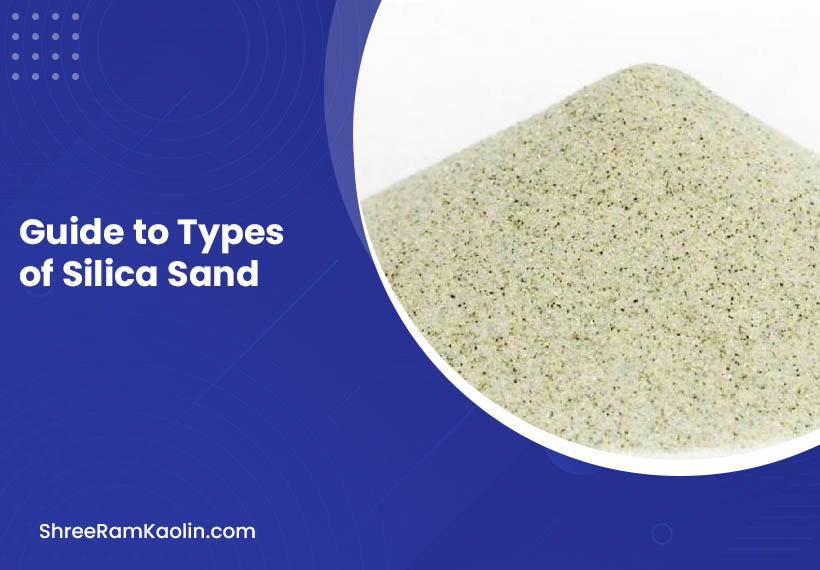A Comprehensive Guide to Types of Silica Sand

Silica sand often referred to as quartz sand is an aggregate material composed of small rock and mineral particles bonded together through particle bonds, with quartz as its major constituent mineral composed of silicon dioxide (SiO2). Silica sand can be found worldwide and has numerous industrial uses.
Chemical Composition
Silica sand is composed primarily of silicon dioxide (SiO2). This element makes up approximately 59% of Earth’s crust and gives silica sand its unique properties that make it invaluable in many industries.
Physical Properties
Silica sand grains usually possess an opaque or transparent appearance with glass-like characteristics, and often score 7 on Mohs’ hardness scale (harder than steel!). Their exceptional hardness coupled with chemical stability make silica particles resistant to weathering or break down.
The Formation of Silica Sand
Geological Processes
Silica sand forms over millions of years through the weathering of quartz-rich rocks such as granite. When these rocks break apart, tiny quartz particles are carried by wind and water and eventually settled as deposits in deposits.
Natural Occurrences
Silica sand deposits can be found all across the world in riverbeds, beaches and dunes; with some significant accumulations occurring in countries like the US, Australia and China.
Common Types of Silica Sand
Now, let’s dive into the different types of silica sand you might encounter:
Industrial Sand
Glass-making Sand
High purity silica sand forms the bedrock of glass production. At least 99.5% pure SiO2, and with extremely low iron levels are necessary. So next time you look through a window or sip from your cup – remember – its origin lies here!
Foundry Sand
Foundry sand, used in metal casting processes, must withstand extremely high temperatures to make its mark as the unsung hero behind many everyday metal objects from car parts to plumbing fixtures.
Fracking Sand
Frac sand, commonly referred to by its initials frac, is used in hydraulic fracturing to extract oil and natural gas, with its crush-resistant, spherical grains helping maintain open fractures for maximum extraction efficiency. It has long been revered as one of the premier products available.
Construction Sand
Concrete Sand
Coarse-grained sand plays an integral part in concrete mixes. It fills gaps between larger aggregates to strengthen and protect concrete structures from breakage, giving concrete its strength and durability.
Masonry Sand
Masonry sand, an ideal material for bricklaying and stucco applications, gives professional masonry projects their trademark smooth finish and is therefore often preferred over concrete sand.
Filter Sand
Water Filtration Sand
Specially graded sand plays an integral part in water treatment plants, helping remove contaminants from our drinking water and filtering out impurities – nature’s own Brita filter!
Pool Filter Sand
Filtration sand designed specifically for swimming pool use provides your pool with crystal-clear waters for safe swimming, keeping its crystal surface and keeping swimmers out. It keeps it crystal-clear.
Specialized Types of Silica Sand
Golf Course Sand

Have you ever considered why golf course bunkers feature distinctive white sand? Often this specialized silica sand has been chosen due to its texture, appearance and drainage properties.
Playground Sand

This type of silica sand has been carefully washed and screened to eliminate harmful particles for children’s safety during play time.
Sandblasting Sand
As part of an abrasive blasting system, this sand can help clean and prepare surfaces in various industries – ranging from shipbuilding to graffiti removal.
Extraction and Processing of Silica Sand
Mining Methods
Silica sand is typically extracted using surface mining techniques – like creating one giant sandbox!
Washing and Grading
Once extracted, silica sand must be washed to eliminate impurities before being divided into its different grain sizes for sorting purposes. This ensures each type of silica sand meets all required specifications for its intended application.
Environmental Considerations
Ecological Impact
Silica sand is an abundant natural material; however, its extraction may have detrimental environmental impacts including habitat disruption and changes to local water systems.
Sustainable Practices
Industry players have increasingly adopted sustainable practices such as land reclamation and water recycling to lessen their environmental impact.
Applications of Different Silica Sand Types
Industrial Uses
Silica sand has long been recognized for its important role as an ingredient of high-tech products like smartphones and solar panels, yet often remains undetected as one of our modern world’s unsung heroes.
Construction Applications
Silica sand can be found everywhere in construction – concrete, mortar, grout and even skyscraper windows contain silica sand.
Environmental Uses
Silica sand goes beyond filtering to contribute to environmental conservation efforts by being used on green roofs and artificial reefs – including green roofs and reefs that use it in green roof systems or artificial reefs.
Choosing the Right Silica Sand for Your Project
Factors to Consider
Consider factors like grain size, purity and specific properties required by your application when choosing silica sand for your application – there’s no “one size fits all!” situation!
Consulting with Experts
For applications requiring specialty silica sands, it’s always wise to consult with an expert who can recommend the ideal type for you.
FAQs
Is silica sand the same as regular beach sand?
Not necessarily. While many beaches do contain silica sand, beach sand can also include other materials like crushed shells or coral, depending on the location.
Can silica sand be harmful to health?
Prolonged inhalation of fine silica dust can be harmful. However, proper safety measures in industrial settings and the use of appropriate personal protective equipment mitigate these risks.
How is silica sand different from desert sand?
Desert sand is often too fine and smooth for many industrial applications. Silica sand used in industry typically has more angular grains and a specific size distribution.
Can I use any type of silica sand for my home aquarium?
It’s best to use silica sand specifically sold for aquarium use, as it’s properly cleaned and sized to prevent harm to fish and filtration systems.
Is silica sand renewable?
While silica sand forms through natural processes, these occur over very long periods. It’s considered a non-renewable resource, emphasizing the importance of responsible use and recycling where possible.
Conclusion
Silica sand plays an invaluable role in our world from tiny grains to massive industrial applications, from its abundance and versatility making it an essential resource across various industries.
As technology develops further and the types and uses for silica sand increase exponentially; understanding all their different varieties helps make informed decisions in projects or industries we participate in.

